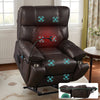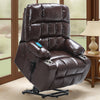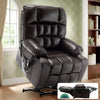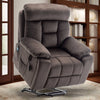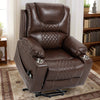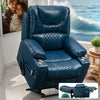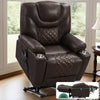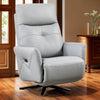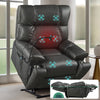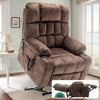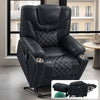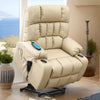Understanding Medicare Coverage
Eligibility Criteria for Lift Chair Recliners
To be eligible for Medicare coverage on a lift chair recliner, certain criteria must be met. Firstly, the person seeking coverage must have Medicare Part B. Additionally, the individual must have a medical condition that necessitates the use of a lift chair. This typically includes difficulties with standing up from a seated position due to arthritis, neurological disorders, or other health conditions that impair mobility. A doctor's certification confirming that the lift chair is essential for the patient's health and mobility is also required. It's important to note that Medicare will not cover a lift chair if it is only needed for comfort or convenience. Only the mechanical lifting component of the chair is covered, not the entire furniture piece.

Covered Lift Chair Recliner Components
When it comes to Medicare coverage for lift chair recliners, it's important to understand which components are included. Medicare generally covers the lifting mechanism, which is the essential part of the chair that assists a person in standing up. However, it does not extend to the entire chair. This implies that the motorized part that lifts the seat is eligible for coverage. Other parts of the chair, such as the frame, upholstery, and any additional features like heating or massage options, are typically not covered by Medicare. Beneficiaries are responsible for these costs. To ensure proper understanding, it is recommended to consult with Medicare or a medical equipment provider to get a detailed breakdown of covered components.
The Process of Getting Medicare Approval
Getting approval for a lift chair recliner covered by Medicare involves a multi-step process. It is important first to ensure that you meet Medicare's eligibility requirements, which typically include having a medical condition that necessitates the use of a lift chair. Once that is established, you will need to acquire a prescription from a Medicare-enrolled physician. This prescription should state that the lift chair is essential in improving, or maintaining, your current condition. Additionally, the physician must fill out and submit specific forms that attest to the medical necessity of the lift chair. After completing these steps, you should select a Medicare-approved supplier who will provide you with the seat lift mechanism – the part of the chair that Medicare will cover. Keep in mind that the entire chair is not covered, so discussions on the costs for the rest of the chair will be necessary. Once all these procedures are in place and the paperwork is submitted, Medicare will review your claim. Approval typically involves processing the claim and then reimbursement for the seat lift mechanism component if the claim is accepted.
Types of Lift Chair Recliners
Benefits of Big and Tall Power Recliners
Big and tall power recliners offer several advantages that are particularly beneficial for individuals with special seating needs. Firstly, they provide ample space and sturdy support for larger body types, ensuring comfort and security. The power lift feature is crucial as it aids users in standing up with ease, reducing strain on the knees and back. This is often a game-changer for those with mobility challenges or recovering from surgery. Additionally, these recliners tend to have stronger motors and reinforced frames to accommodate heavier weights, offering a durable and long-lasting solution. Convenience also comes in the form of adjustable positions and customizable controls that allow users to find their ideal seating angle for maximum relaxation or therapeutic benefits. Overall, big and tall power recliners not only enhance comfort but also promote independence and improve the quality of life for users.
Features to Consider When Choosing a Recliner
When selecting a lift chair recliner, especially if you're looking for a big and tall power recliner, it's crucial to consider certain features that will ensure comfort, functionality, and longevity. Some key features to keep in mind include:
- Size: Ensure that the recliner fits your body dimensions, particularly for big and tall users. Look for models that offer ample seating space and a sturdy frame.
- Weight Capacity: Check the maximum weight the recliner can support to guarantee safety and durability.
- Lifting Mechanism: Choose a powerful and smooth motor that can lift and recline with ease, providing the necessary assistance.
- Recline Range: Consider recliners with a wide range of recline options for optimal comfort and therapeutic benefits.
- Material: Look for high-quality fabrics or leather that are durable and easy to clean, particularly important for frequent use.
- Adjustability: Adjustable features such as footrests and headrests add to comfort and personalization.
- Accessories: Additional perks like heated seats, massage functions, or built-in USB ports can enhance the user experience.
- Warranty: Opt for a recliner with a solid warranty that covers the lift mechanism and other essential components.
Remember to assess your needs and compare them against these features to choose a recliner that provides the best support and convenience.
How to Qualify for a Medicare-Covered Lift Chair
Medical Necessity Documentation
To qualify for a Medicare-covered lift chair, the first step is securing medical necessity documentation. This crucial paperwork must clearly demonstrate that a lift chair is essential for the user's health and mobility. Generally, the documentation should include a detailed explanation of the individual's medical condition and how a lift chair would benefit them. Typically, a physician or healthcare provider will need to assess the patient's mobility limitations and physical health to determine if a lift chair is the appropriate assistive device. This assessment is then formally documented, indicating the expected therapeutic benefits and justifying the medical necessity of a lift chair for the patient. This documentation is vital when submitting a claim to Medicare to cover the cost associated with the chair's seat lifting mechanism.
Physician Prescriptions and Evaluations
To become eligible for a Medicare-covered lift chair, one must first obtain a physician's prescription. This involves a face-to-face evaluation conducted by your doctor, who will assess your specific needs and determine if a lift chair recliner is a medical necessity. During the evaluation, the physician will look for conditions that limit your mobility, such as severe arthritis or other neuromuscular diseases. The documentation must explicitly state how the chair will assist in improving your condition or the daily functions that are currently impaired. After obtaining the prescription, you'll need to find a Medicare-approved supplier to ensure the lift mechanism is covered. Keep in mind that Medicare will not cover the full cost of the chair, but only the lifting mechanism, and the documentation should reflect this requirement.
The Cost Aspect of Lift Chair Recliners
Exploring Part B Deductibles and Co-payments
When it comes to the cost of lift chair recliners, Medicare Part B plays a crucial role for those eligible. Part B includes medical insurance which often covers durable medical equipment (DME), like the lifting mechanism of lift chairs. Before Medicare helps pay for this equipment, beneficiaries must meet the Part B deductible, which is an annual amount you pay before Medicare starts to pay its share. After meeting the deductible, you will typically be responsible for 20% of the Medicare-approved amount as co-payment, while Medicare pays the remaining 80%. It's important to be aware that Medicare will only cover the cost of the lifting mechanism, and not the entire recliner chair, leaving the rest of the expenses to be out-of-pocket or covered by other means of funding.
Possible Additional Costs for Big and Tall Recliner Models
When considering a big and tall power recliner with lift functionality, additional costs may arise beyond what Medicare covers. Medicare typically pays for the seat lifting mechanism, but not the entire chair. Therefore, customers may face extra charges for the size and construction of the chair itself, tailored for larger individuals. The enhanced frame and material durability to support additional weight and height can also contribute to a higher price. Special features such as extra cushioning, heat and massage systems, or a more extensive choice of fabrics and colors might add to the cost. Always check for any added expenses when selecting a big and tall model to avoid surprises.
Alternative Funding Options
Medicaid and Other State Programs
Medicare coverage for lift chairs is often limited to certain components, and beneficiaries may need to seek out alternative funding options to assist with expenses. Medicaid, for instance, can act as a potential resource for those eligible for additional governmental aid. Various state assistance programs may also offer subsidies or grants aimed at helping individuals with the purchase of medical equipment like big and tall power recliners. It's crucial to check with your local Medicaid office or state-funded programs to find out what specific benefits you may qualify for. Each state has different eligibility requirements and benefits, so understanding the unique offerings provided in your state is essential for optimizing financial assistance opportunities.
Charitable Organizations and Financial Assistance
For those who may not be fully covered by Medicare or face additional costs for big and tall power recliner models, exploring alternative funding options is crucial. Charitable organizations oftentimes step in to assist individuals who require financial assistance for medical equipment, including lift chairs. Organizations like The Assistance Fund, Help Hope Live, and The National Association for the Physically Handicapped have programs that can help subsidize the cost or even provide lift chairs at no cost to those who meet certain criteria.
Moreover, local community groups, churches, and non-profits sometimes have funds reserved for residents in need of medical support devices. It's worthwhile to connect with social workers or healthcare coordinators who might be aware of grants and local charities that offer assistance. Such programs may have specific application processes and might require proof of income, medical necessity, or residency, so it's good to gather necessary documents in advance. Additionally, online crowdfunding platforms have become a popular way to raise funds for health-related needs, including specialized furniture like lift chairs for individuals who are big and tall.
Steps for Purchasing a Medicare-Approved Lift Chair
Finding Suppliers and Handling Reimbursements
For those eligible for a Medicare-approved lift chair, locating suppliers and arranging reimbursements is a critical step. Begin by searching for Medicare-approved medical equipment suppliers in your area. They must accept assignment, meaning they agree to the Medicare-approved amount for the lift chair component. Once a supplier is found, discuss your lift chair needs, specifically highlighting that you require a big and tall power recliner if it applies to you.
After purchasing, submit a claim to Medicare with the necessary paperwork, which includes the prescription from your healthcare provider and proof of purchase. Medicare will then reimburse you for the Medicare-covered portion, which typically pertains to the lifting mechanism. Remember, the process may vary slightly depending on your location, so it's advisable to consult with your chosen supplier on the specific steps for reimbursement. Keep all receipts and documentation for your records and future reference.
Installation and Maintenance Tips
Once you've received Medicare approval and selected a Medicare-approved lift chair, the next steps include installation and proper maintenance to ensure longevity and safety.\n\n### Installation\n- Verify the delivery team's qualifications to ensure safe and correct installation.\n- Look for secure power sources and avoid using extension cords to prevent hazards.\n- Follow the manufacturer's instructions or consult a professional for assembly.\n- Ensure the chair's location offers stability and is free from obstacles.\n\n### Maintenance Tips\n- Clean the chair with recommended products to avoid damage to surfaces.\n- Regularly check the power cables and moving parts for wear and tear.\n- Schedule routine inspections by a qualified technician to maintain mechanics.\n- Report any malfunctions to the supplier immediately for repair or replacement.\n\nThese steps will help keep your recliner in top condition, offering comfort and support for years.
Real-Life Experiences
Testimonials and User Stories
Hearing from individuals who've personally benefited from big and tall power recliners can offer valuable insights. Common testimonials highlight how these specialized chairs enhance comfort and improve the quality of life for those with mobility issues. Users often share stories of increased independence, as the power recliner allows them to sit and stand without assistance. The lift feature is frequently mentioned as a life-changer, particularly for those who have undergone surgeries or suffer from chronic conditions that affect movement. For larger individuals, the additional space and robust design of big and tall models provide the necessary support and durability, adding to customer satisfaction. Such real-life experiences underscore the importance of Medicare's coverage for those in need of assistive furniture.
Additional Considerations
Impact on Mobility and Independence
When considering a lift chair, particularly for individuals requiring a big and tall power recliner, it's crucial to reflect on the device's impact on mobility and independence. A lift chair can considerably enhance the quality of life for those with limited mobility by providing support to sit and stand without assistance. This not only fosters a sense of self-reliance but also reduces the risk of falls and injuries. Additionally, being able to move freely at home can help maintain muscle strength and flexibility, contributing to overall health and well-being. Therefore, choosing the right lift chair is significant, as it directly influences daily activities and autonomy.
Choosing the Right Lift Chair for Your Home
Selecting the perfect lift chair for your home involves considering several factors. Firstly, the size of the chair should match your body dimensions, especially if you're big and tall. Ensure the chair provides adequate support and comfort for your stature. Secondly, assess the space where the chair will reside. There must be ample room for the chair to recline fully without hindrance. Additionally, consider the decor and aesthetics of your home. The chair's style and color should complement your existing furnishings. Look for a lift chair that also offers the right level of independence, allowing you to sit and stand with ease. Lastly, prioritize chairs known for their durability and easy maintenance, ensuring your investment stands the test of time.








